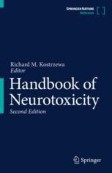Search
Search Results
-
Botulinum Neurotoxins for Relief of Pain Associated with Spasticity
Spasticity is a common and disabling complication of stroke, multiple sclerosis, brain and spinal cord injury, neurogenetic disorders, and cerebral...
-
Light Chain Role in Action of Botulinum Toxins/Clostridial Neurotoxins
The clostridial neurotoxins (CNT), botulinum neurotoxins (BT) and tetanus neurotoxin (TT), are the most toxic protein toxins for humans. BT isolates...
-
Botulinum Neurotoxins as a Therapeutic
Since first recognized as the cause of food-borne botulism in the early nineteenth century, botulinum toxin was suggested as a potential treatment...
-
Beyond Botox: Other Neurotoxins—What Are Similarities and Differences?
This chapter describes the pharmacological and clinical characteristics of six botulinum toxins—Botox, Xeomin, Dysport, Myobloc, Jeuveau and...
-
Botulinum Neurotoxins: Mechanism of Action
Botulinum neurotoxins (BoNTs) are a growing family of bacterial protein toxins that cause botulism, a rare but often fatal animal and human disease....
-
Susceptibility of GPCR Heteroreceptor Complexes to Neurotoxins. Relevance for Neurodegenerative and Psychiatric Disorders
G protein-coupled receptors (GPCRs) possess significant patterns of intrinsic unfolding. GPCRs have similarities to proteins that have a high net...
-
Susceptibility of GPCR Heteroreceptor Complexes to Neurotoxins. Relevance for Neurodegenerative and Psychiatric Disorders
G protein-coupled receptors (GPCRs) possess significant patterns of intrinsic unfolding. GPCRs have similarities to proteins that have a high net...
-

-
Botulinum Neurotoxins as a Therapeutic
Since first recognized as the cause of food-borne botulism in the early nineteenth century, botulinum toxin was suggested as a potential treatment...
-
How Do Bacterial Neurotoxins Affect Neurosecretion?
The mechanism by which bacterial toxins alter or interfere with secretion mechanisms are addressed in this chapter. After a brief description of the...
-
Psychoactive Medicinal Plants and Fungal Neurotoxins
This book provides a clear and comprehensive overview of psychoactive medicinal plants, explaining in detail the species that are most commonly used...

-
Autism Spectrum Disorder Initiation by Inflammation-Facilitated Neurotoxin Transport
Autism spectrum disorders have been linked to genetics, gut microbiota dysbiosis (gut dysbiosis), neurotoxin exposures, maternal allergies or...

-
Molecular Structure and Mechanisms of Action of Botulinum Neurotoxins
Botulinum neurotoxins (BoNTs) are a growing family of bacterial protein toxins that cause a generalized flaccid paralysis of botulism by inactivating...
-
Novel Native and Engineered Botulinum Neurotoxins
Botulinum neurotoxins (BoNTs), produced by Clostridia and other bacteria, are the most potent toxins known. Their cleavage of the soluble...
-
Handbook of Neurotoxicity
This handbook is a reference source for identifying, characterizing, instructing on use, and describing outcomes of neurotoxin treatments – to...
-
The History of Botulinum Neurotoxin Development
This chapter provides information on the history and development of botulinum neurotoxins as a therapeutic tool in clinical medicine. It discusses...
-
Treatment of Dystonia: Medications, Neurotoxins, Neuromodulation, and Rehabilitation
Dystonia is a complex disorder with numerous presentations occurring in isolation or in combination with other neurologic symptoms. Its treatment has...
-
Botulinum Toxin Treatment What Everyone Should Know
This book explains and discusses in simple language the structure and function of botulinum toxin and other neurotoxins as well as the rational for...

-
The Emerging Role of Astrocytic Autophagy in Central Nervous System Disorders
Astrocytes act as “housekee** cells” for maintaining cerebral homeostasis and play an important role in many disorders. Recent studies further...

-
Diverse and Dynamic Alpha-Neurotoxicity Within Venoms from the Palearctic Viperid Snake Clade of Daboia, Macrovipera, Montivipera, and Vipera
The targeting of specific prey by snake venom toxins is a fascinating aspect of molecular and ecological evolution. Neurotoxic targeting by elapid...

